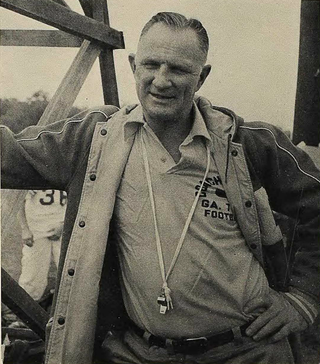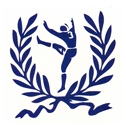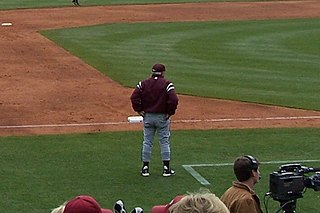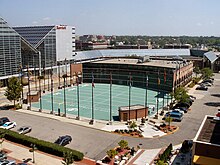
Robert Lee Dodd was an American college football player and coach, college baseball coach, and college athletics administrator. He served as the head football coach at Georgia Tech from 1945 to 1966, compiling a record of 165–64–8. His teams won consecutive Southeastern Conference (SEC) title in 1951 and 1952, and his 1952 Georgia Tech Yellow Jackets football team won the 1953 Sugar Bowl and was recognized as a national champion by a number of selectors though they finished second behind Michigan State in both major polls. Dodd was also Georgia Tech's head baseball coach from 1932 to 1939, tallying a mark of 43–64–2, and the school's athletic director from 1950 until 1976. All together, Dodd served Georgia Tech 57 years in various capacities.

Vincent Joseph Dooley was an American college football coach. He was the head coach of the Georgia Bulldogs from 1964 to 1988, as well as the University of Georgia's (UGA) athletic director from 1979 to 2004. During his 25-year head coaching career, Dooley compiled a 201–77–10 record. His teams won six Southeastern Conference (SEC) titles and the 1980 national championship. After the 1980 season, Dooley was recognized as college football's "Coach of the Year" by several organizations.

The Georgia Bulldogs football program represents the University of Georgia in the sport of American football. The Bulldogs compete in the Football Bowl Subdivision (FBS) of the National Collegiate Athletic Association (NCAA) and the Eastern Division of the Southeastern Conference (SEC). They play their home games at historic Sanford Stadium on the university's Athens, Georgia, campus. Georgia claims four consensus national championships ; while the AP and Coaches Polls have each voted the Bulldogs the national champion three times. Georgia has also been named the National Champion by at least one polling authority in four other seasons.

The William V. Campbell, formerly the Vincent dePaul Draddy Trophy, is awarded by the National Football Foundation to the American college football player with the best combination of academics, community service, and on-field performance. It is considered by many to be the "Academic Heisman" and nicknamed as such.

Joseph Fitzgerald Hamilton is an American former professional football player who was a quarterback in the National Football League (NFL), NFL Europe and Arena Football League (AFL). He played college football for the Georgia Tech Yellow Jackets, earning consensus All-American honors and winning the Davey O'Brien Award in 1999. After his playing career ended, Hamilton became an administrator and coach. He has served as the running backs coach for Georgia State University and currently works in the recruiting department for his alma mater, Georgia Tech.

The National Football Foundation (NFF) is a non-profit organization to promote and develop amateur American football on all levels throughout the United States and "developing the qualities of leadership, sportsmanship, competitive zeal and the drive for academic excellence in America's young people." It was founded in 1947 with early leadership from General Douglas MacArthur, longtime Army Black Knights football coach Earl Blaik and journalist Grantland Rice.

George Edkin Little was an American football player, and coach of football, basketball, and baseball, and college athletics administrator.

Robert Grier Sr. is a former college football player for Pitt. In 1956, he was the first African American football player to break the color barrier of the United States collegiate Sugar Bowl game, which was held in New Orleans. Particularly in the deep South, the mid-1950s was a period of strident racial segregation for sports, as well as other areas of life. At the time, Grier's participation in a fullback and linebacker against a segregated all-white team on such a prestigious "stage" was a tremendously significant event.

The Michigan State Spartans football program represents Michigan State University (MSU) in college football at the NCAA Division I Football Bowl Subdivision (FBS) level. The Spartans are members of the Big Ten Conference. Michigan State claims a total of six national championships, including two from major wire-service: AP Poll and/or Coaches' Poll. The Spartans have also won eleven conference championships, with two in the Michigan Intercollegiate Athletic Association and nine in the Big Ten.

Bernie Hawthorne Moore was an American college football, basketball, track and field coach and college athletics administrator. He served as the head football coach at Mercer University (1926–1928) and Louisiana State University (LSU) (1935–1947). Moore was also the head basketball coach at Mercer (1926–1928) and the head track and field coach at LSU (1930–1947). He was then SEC commissioner from 1948 to 1966. He was inducted into the College Football Hall of Fame in 1952.

The Pittsburgh Panthers football program is the intercollegiate football team of the University of Pittsburgh, often referred to as "Pitt", in Pittsburgh, Pennsylvania. Traditionally the most popular sport at the university, Pitt football has played at the highest level of American college football competition, now termed the NCAA Division I Football Bowl Subdivision, since the beginning of the school's official sponsorship of the sport in 1890. Pitt competes as a member of the Atlantic Coast Conference (ACC).

The Clemson Tigers are the American football team at Clemson University. The Tigers compete in the NCAA Division I Football Bowl Subdivision (FBS) of the National Collegiate Athletic Association (NCAA) and the Atlantic Division of the Atlantic Coast Conference (ACC). In recent years, the Tigers have been ranked among the most elite college football programs in the United States.

Ronald George Polk is an American professional coach in NCAA Division I college baseball. He was a long-time head baseball coach at Mississippi State and is considered to be the "Father of Southeastern Conference Baseball." Polk compiled one of the most successful winning records, as a coach, in both MSU and Southeastern Conference history. In 31 seasons as an SEC coach he compiled a 1218-638-2 (.656) record. His career record stands at 1373-702-2. He currently ranks 9th on the all-time wins list nationally for 10+ year Division I coaches. His teams won five SEC championships and five SEC tournament championships. His teams participated in the NCAA tournament twenty-three times, and reached the College World Series eight times.
The MacArthur Bowl is a trophy awarded annually by the National Football Foundation (NFF) to the NCAA Division I Football Bowl Subdivision college football team(s) that are recognized by the NFF as the National Champions for that season.

A national championship in the highest level of college football in the United States, currently the NCAA Division I Football Bowl Subdivision (FBS), is a designation awarded annually by various organizations to their selection of the best college football team. Division I FBS football is the only National Collegiate Athletic Association (NCAA) sport for which the NCAA does not sanction a yearly championship event. As such, it is sometimes referred to as a "mythical national championship".

The Centre Colonels football team, historically also known as the Praying Colonels, represents Centre College in NCAA Division III competition. The Colonels currently play in the Southern Athletic Association (SAA), which was established in 2011. Before the establishment of the SAA, Centre played 50 seasons in the Southern Collegiate Athletic Conference (SCAC). Despite the school's small size, the football team has historically had success and possesses a strong tradition. At the end of the 2008 season, the school ranked as the 12th winningest school in Division III with an all-time record of 509–374–37.




















